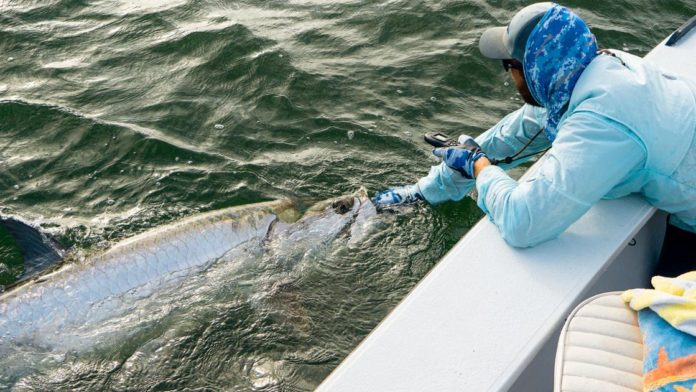It has just officially turned summer, and in Southwest Florida the tarpon fishing is in full swing and fly fishing is in its glory. There are fish from 20 to 200 pounds on the beaches, in the passes, around the backcountry, and spreading out into the open waters of the Harbor. We’re going out with 11- and 12-weight rods under the gunnels of the boat. The fly boxes are filled with an assortment of 1/0 to 6/0 flies resembling different bait fish, crabs and shrimp.
Tarpon time here isn’t for delicate daisies. The hotter and more humid, the better! It’s 95 degrees at 4 p.m., then a thunderstorm comes and goes. You can hardly breathe because the air is so thick and heavy … but then what happens? The wind dies. The water slicks off and fish start to roll. It’s about to be on.
You make your cast and the line straightens out as the leader turns over. The fly hits the water and starts to sink. You make a long, slow strip, then maybe another. The line comes unexpectedly tight and you feel that familiar “thunk.” You make a hard strip — and suddenly the mirror-smooth water is blown into oblivion. In front of you is one of the most revered sights in the fly fishing world: A tarpon 8 feet in the air, shaking its head, the rattling gills making a noise like chain mail in a medieval battle.
If you’re lucky, the hook stays in place for the next few brain-rattling jumps. An isometric tug-of-war ensues, and within 15 to 20 minutes you have the silver king at the side of your boat. I know you are hot and tired, but pay your respects to the king and spend as long as it takes to revive and release him in good shape. It may take another 15 to 20 minutes, but make sure they break loose from your grip and swim off strongly. Don’t allow these fish to fade off in a spiral to the bottom and die.
We haven’t had many of those days with slicked-off water yet; it’s been sporadic. But they are coming, and it will be even hotter and more humid than it is now. This incessant wind will be gone, the swells will drop and the chop will smooth out. The heat and storms will remain. Remember, summer has barely begun, so the days of feeling like you are wearing a wet electric blanket outside are soon to be here.
With that in mind, how do you take care of yourselves out on the boat in the heat? First things first: Dress the part. There are all kinds of great moisture-wicking, quick-drying, SPF-rated clothing options on the market. If you plan to spend any time on the water anywhere this summer, invest in what will suit your needs. SPF ratings of 15 to 50 are common.
Find a shirt with an open cape back and/or sides for maximum ventilation. I wear long-sleeve shirts here year round on the water. I know, sounds hot — but moisture-wicking cloth is a modern miracle, and on ho days my skin is cooler covered with a layer of it than if I leave it bare. Bonus: Less sun exposure, lowered risk of skin cancer.
If you want to expose some skin, pants that are convertible to shorts with zip-off legs may be helpful for staying cool. A hat will help to protect your head and face. A wide brim will give you a lot more shade than a ball cap. I also always wear a buff to help protect my face, neck and ears. You can dunk these in the water from the ice chest once in a while to help keep you cooled off. Sun gloves may be an option for you also. I try to wear them, but they just bug me when I am using the push pole.
I’m always barefoot on the boat, like most fly guys. It helps to be able to feel the line when you step on it. If you’re worried your tootsies might get too toasted, have a pair of socks handy to help avoid the burn.
Protect your eyes with a good pair of sunglasses. Almost all sunglasses sold today provide good protection from the sun’s harmful UV rays. For the anglers, polarized lenses are a must. They not only protect against the sun but also cut the glare on the surface of the water so we can see into the water. The polarization will give us good contrast, so we can spot the fish more easily for our sight fishing. I like mine to wrap around my face as much as possible to reduce glare from the sides.
Use sunscreen, and use it often. You can get sunscreen from 15 to 100 SPF. Apply it before you get on the boat and then periodically throughout the day. I prefer sunscreen sticks over lotion — less messy to apply. Don’t forget SPF lip balm.
Never take spray-on sunscreen on a boat, especially a fishing boat. The spray will turn the deck of the boat orange, and it has to be scrubbed and bleached off. It also will damage your line — not cool when your basic fly line costs 100 to 120 bucks these days. This also goes for bug sprays also, since it’s the propellant that causes the problems.
Can you believe that I have to tell clients to drink water, and sometimes even insist on it? I know … you get excited, you’re thinking about that tarpon, making the cast, bowing when it jumps, wondering if your knots will hold — the list goes on. I will at times have to get down from the poling platform, put my push pole away, take their rod away, hand them a bottle of water and demand they sit down and drink it. C’mon, man! You’re fishing for a strike, not a stroke!
You have to stay hydrated in these conditions. They say if you get thirsty, it’s too late — you’re already beginning to dehydrate. I don’t know about that, but you do need to drink more than you think you need drink. Make sure to have a few sports drinks in the cooler, too. These will help replenish the salts and other minerals you will lose from excessive sweating. Avoid caffeinated and alcoholic beverages. They will accelerate your dehydration because caffeine and alcohol are diuretics. Save the beer for afterward!
All of this is important, because it helps you stay on the water and possibly catch more tarpon. I can’t say enough about these fish — I never get tired of them. In all honesty, they are one of the main reasons I live here. From now through September, I will often daydream about standing in 55-degree stream water with a 4-weight in my hand and a dry/dropper tied on, in hopes of a nice little brown, rainbow or golden. But if I were actually standing in that stream, I’d just be daydreaming about the tarpon fishing here, in and around Charlotte Harbor.
Stay fly!
Capt. Rex Gudgel is a fly fishing guide in the Boca Grande area and an International Federation of Fly Fishers Master Certified casting instructor. If you’d like to get casting lessons, book a trip or just need more fly fishing info, contact him at 706-254-3504 or visit BocaGrandeSlamFlyFishing.com or CastWithRex.com.
Credit: Source link































